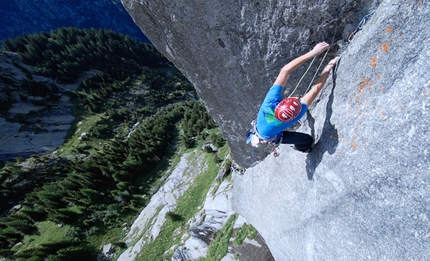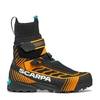Jonas Schild repeats Joy Division on Monte Qualido in Val di Mello, Italy
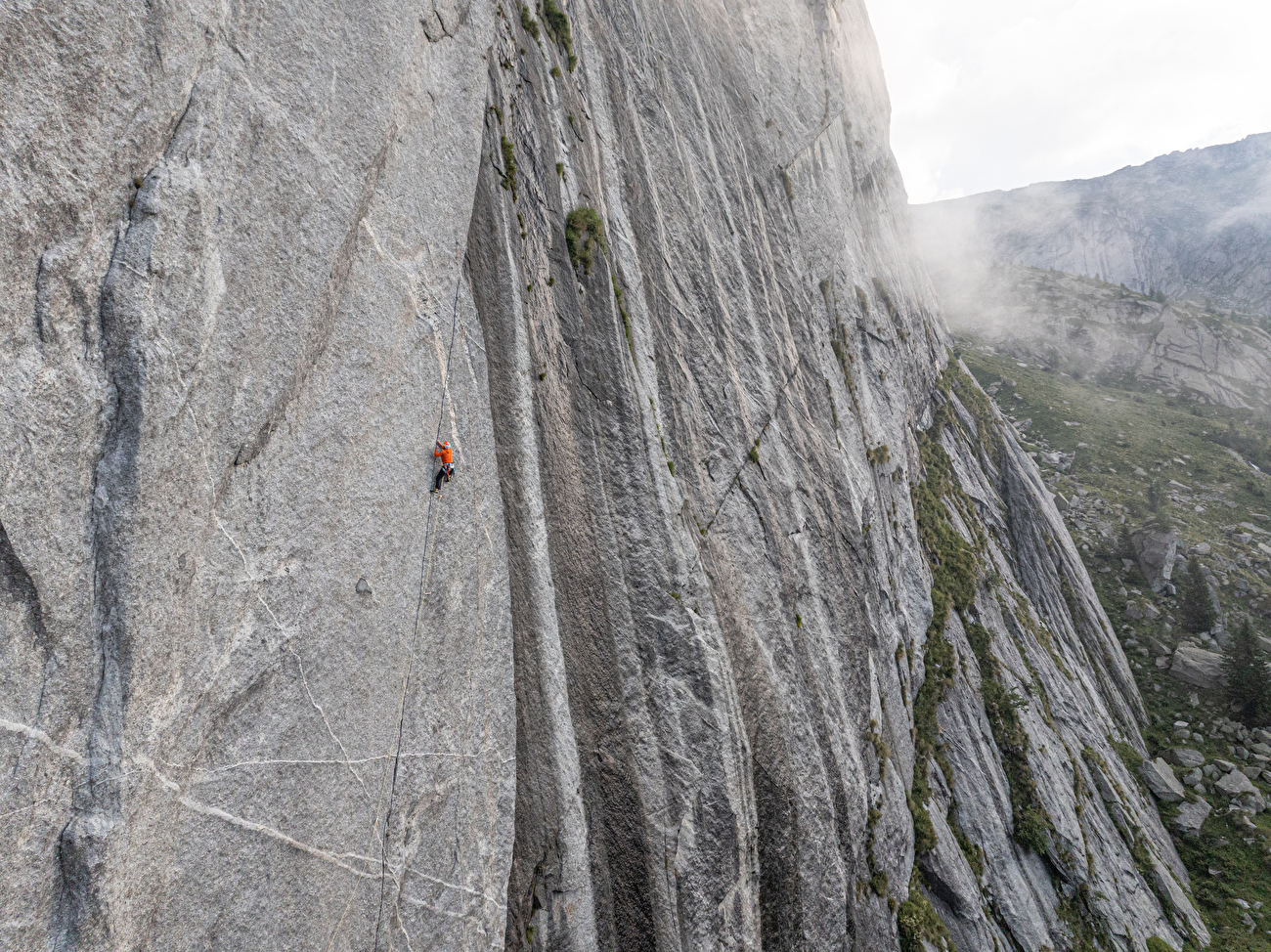
 1 / 26
1 / 26 Diego Schläppi
Diego Schläppi
Thomas Schmid and I had been planning a climbing trip together for a long time. At the beginning of June, the weather in Val di Mello was perfect, so we made a quick decision: to attempt a free ascent of Joy Division on Torrione Qualido. This 800-meter rock giant had been on my mind for a long time. In terms of length, style, and difficulty, it is every bit as impressive as El Capitan in America. The route is a combination of three existing lines, which were first climbed in 2004 by local climbing legend Simone Pedeferri, albeit in several stages on different days. Only a few continuous ascents are known from the last 20 years, such as those by James Pearson in 2011 or Barbara Zangerl and Jacopo Larcher in 2021.
On the first day, the wall was still mostly wet, with only the first pitch dry. This 8b is also the most difficult of the entire route. We used the day to check out this length, which is a a real challenge. Climbing of this difficulty on less than vertical terrain is usually very complex. By the evening, however, we had both found a workable solution and were already climbing really well. Afterwards, we rewarded ourselves with a delicious three-course Italian meal down in the valley.
The next day, we went back up to check out pitches one through four. As it was still raining in the morning, we started relatively late. This had the advantage that we were able use the good afternoon conditiona. The wall is completely exposed to the sun until just after 2:00 p.m. As Babsi Zangerl and Jacopo Larcher had already written, the next two pitches are only rated 7b+, but they are definitely challenging. The fourth pitch is then rated 8b again. Here, too, it was relatively difficult at first to figure out how to climb the pitch. But once we worked out the beta, the climbing went relatively well.
We deserved a rest day down in the valley the next day. Then we went back up to check out the next pitches. The goal was actually to climb up to pitch 11 of the original line, which is rated 7c+, after which the climbing becomes much easier. However, things didn't go according to plan. We were climbing in the blazing sun and realised that between 10:00 a.m. and 2:30 p.m., any difficult climbing was out of the question. But we had to check it out somehow. The fifth pitch – rated 7a – was quite easy. This was followed by a 7a+. This one has a fairly slabby boulder crux in the middle. Then comes a slabby 7b+ with two boulder sections. 7b+ doesn't sound particularly difficult on paper, but on granite that isn't even vertical, it's quite a challenge. In the blazing sun, it seemed almost impossible. Somehow, though, I managed to find a solution. The next pitch, a grassy 6a+, was still a bit wet but went quite well. After that, I climbed a few more meters of the traversing 7b+. This was also still skightly wet. I realised that if we continued here, we wouldn't be able to abseil down the route, so we decided to turn back. The sun had really beat us up and we wanted to check out a few of the more difficult lower pitches that same day. Without having looked at the last difficult pitches, we returned back to the valley.
On the way down, we had to seriously rethink our strategy. We realised that our original plan to climb the route in a single day was not realistic. The heat until almost 3:00 p.m., the sustained, challenging climbing, and the length of the wall prompted us to find a portaledge and try the route over two days. This way, we could climb early in the morning, take a siesta on the ledge at noon, and then continue climbing until dark. So this second rest day was pretty much spent sorting out logistics. Thanks to Niccolò Bartoli, we quickly found a portaledge. In between shopping and rushing back up to the bivouac below the wall (Hotel Qualido), we relaxed a bit by swimming down in the valley.
The next morning, the alarm clock woke us up at 5:00 a.m. We wanted to take advantage of the good conditions in the early morning. What followed felt like a pure climbing thriller to me.
Before 7 a.m., completely sleepy and not warmed up, I start the first pitch. The plan is actually to check out the moves again to warm up. The first 10 meters to the first boulder section are relatively easy, then comes a no-hand rest. I consider whether I should quickly hang and rest on the rope, but decide against it and soon continue climbing into the boulder. Delicate foot changes, thumb supports, and always on the edge between standing fully on my feet and still taking some weight off my fingers so that my feet won't slip. To my complete amazement, I manage this part relatively easily. Now I'm getting nervous. Is this going to be a promising attempt after all? I rest briefly and continue upwards. With a mix of being not quite awake and nevertheless completely focused, I manage the upper part of this section, and before 7 a.m., the hardest part of the climb is suddenly in the bag. Now there are “only” 19 sections left that have to be completed without falling.
Thomas lowers me down again so I can belay him. However, the sun is now on some of the pitch, which immediately heats up the rock. Thomas gives it a try anyway, but falls on the first boulder. Instead of hoping for a second attempt, he quickly decides to give up his own free climbing ambitions for the sake of the team. What a kind gesture! We had agreed in advance that we would adopt Babsi and Jacopo's tactic: all pitches 8a or harder would be climbed on lead by both of us, bellow 8a we' swing leads but without rope assistance and without falling when following. So we continue in this manner.
The next two 7b/7b+ pitches demand everything we've got. We've only climbed them once before, and both are really tough for their grade. Before the fourth pitch, we set up the portaledge and wait for the shade. The wait is brutal, as there are still 17 pitches to go, 11 of which are unknown. It's also tiring, and I'm slowly realizing that I'm not fully recovered from the hiking and climbing of the previous days. Doubts arise. But as soon as the shade arrives, I get started with focus. All the moves are easy. Before reaching the belay, I make a small mistake and fall into one of the old, rusty 8 mm bolts. Back down, I belay Thomas on the pitch. Despite failing on the first pitch, he is motivated to keep climbing and just have fun. This is extremely helpful for me. It allows us to enjoy the time in a relaxed atmosphere despite the pressure from my side. On the second attempt, everything goes well, and the two most difficult pitches are completed. We climb the next pitches, 7a, 7a+ and 7b+, making quick progress and benefiting from the afternoon shade. However, I notice that I have to concentrate extremely hard. The difficulties are no longer super high, but we only had a quick look at these pitches. They mainly consist of slabby, boulder sections. This means that the slightest mistake can cause your foot to slip, which means a fall. Fortunately, everything goes without a fall, and by 8:00 p.m. we are at the seventh pitch, where we set up the portaledge. Before getting ready for the night, we enjoy a Birra Moretti with some bresaola and local cheese. What an awesome aperitif. But now I realize that my free climbing ambitions are becoming more realistic. However, we're not quite sure which route we want to climb: the original route or, like Babsi and Jacopo, switch to “Con un piede in paradiso” after pitch nine for four pitches. This route has a more difficult pitch than the original line, but is said to be less grassy. Somewhat desperate, I write to them from the portaledge. Thanks to their good advice, I am already leaning towards switching to the other line in the evening. However, we wait with the decision until we are there.
The next morning, we get off to an early start again. The 6a+ after the bivouac is just perfect for warming up. After that, a traversing 7b+ awaits us, which is the only pitch so far without bolts, but can be secured well. I manage it on the first try, which is another important piece of the puzzle for success. Checking it out and trying again would have been time-consuming and exhausting because of the traverse. The 7a and 7c+ of the original line look extremely grassy. So we decide to switch to the other line to the right. Thomas climbs a beautiful 6c+ dihedral – pure climbing pleasure. After that, we are at the belay below the last difficult pitch, an 8a (6b+/A1), which starts with a slab and ends with an overhanging crack. But for now, climbing is out of the question due to the temperatures. We set up the ledge again and take a siesta. Doubts arise once more. The plan had actually been to be back down by this evening, and we still have 10 pitches ahead of us. Fortunately, we have some extra food and water with us. This makes me feel positive. After 2:00 p.m., I start the pitch to check it out. I'm having a really hard time finding a solution. After over an hour, I'm back down with serious doubts about whether I can still manage this pitch. Thomas gives me a motivating kick in the butt: “Now you climb this pitch, then we'll get through. I haven't been supporting you for two days so you can mess up here because of an 8a pitch.” Exactly what I needed. On my first attempt, I make a mistake at the bottom of the slab. I take another look and climb the pitch five minutes later. What a relief. But now it's already 4:00 p.m. We leave the portaledge hanging and continue climbing. Now all doubts are gone.
Thomas climbs the next pitch, a technical short 7a, and marks the holds and footholds for me. I manage the boulder without any major problems. But on the last few meters to the belay, I suddenly feel the first raindrops. I can't believe it: is a thunderstorm going to ruin our plans? In all the stress of climbing, I didn't even notice that huge storm clouds had gathered around us. A glance at the radar shows that a thunderstorm could be coming in the next few hours. However, we decide to push on as long as we can. After the next pitch, we reach the large ledge with dark clouds behind us but no rain. From here, we traverse diagonally to the right to reach the Melat route. Here, the terrain becomes somewhat alpine: grass-covered ledges and dihedrals. After two adventurous pitches, we find ourselves back on the line. In order to get back over here when abseiling, we fix the rope we used to haul our bags. Then the clouds clear, and after four more beautiful and moderate pitches, we stand happily on the summit at 9:00 p.m. After a hug and a short break, we soon begin rappelling into the night. Thanks to the fixed rope, this goes without any major complications. At half past midnight, we are back in the portaledge and spend another night on this incredible wall. We rappel down to the base the next morning.
We spent a total of five days on the route. For me, it was definitely one of the most memorable climbing experiences I've ever had. To free climb so many challenging meters in such a short time, and in such difficult conditions due to the heat and the exposure of the wall. Without Thomas's brilliant support, this would not have been possible. Special thanks also go to Niccolo Bartoli, who lent us his portaledge and supported us in many ways, and to Babsi and Jacopo for their helpful last-minute tips. I'm already looking forward to my next trip to Val di Mello.
- Jonas Schild, Bern, Switzerland
JOY DIVISION
Joy Division was first ascended by local climber Simone Pedeferri and is a combination of three routes, the first three pitchs of Forse si, forse no (Igor Koller, Peter Machai, Miro Piala, 1996) followed by Mellodramma (Gianni & Paolo Covelli, Silvio Fieschi, Fabio Spatola, 1989) up to the 15th pitch to then finish up Melat (Sonja Brambati, Adriano Carnati e Paolo Vitali, 1993). Pedeferri climbed the line over three different days in summer 2004: the first three pitches one evening in July, up to pitch 11 the next day and then, after retreating due to a storm, the final pitches. The first single-push free ascent was made by James Pearson in 2011, followed by Barbara Zangerl and Jacopo Larcher in 2021. Just like Zangerl & Larcher, at pitch 10 Schild and Schmid chose not to follow the original 7c+ but instead followed 4 pitches of Con un piede in paradiso (8a) before joing Melat.



 Copia link
Copia link


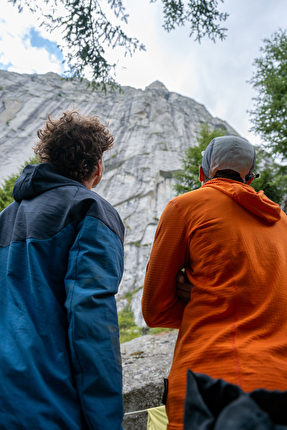




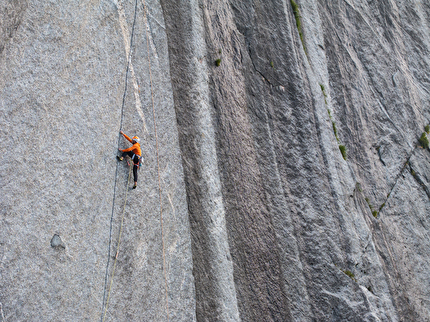
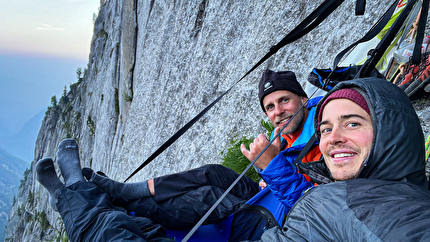





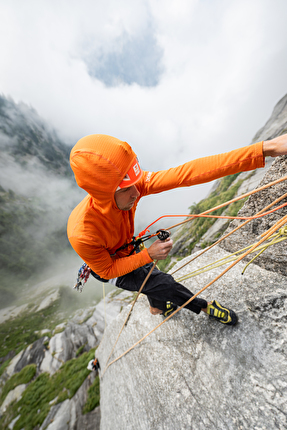

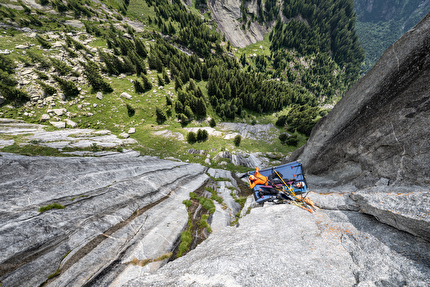
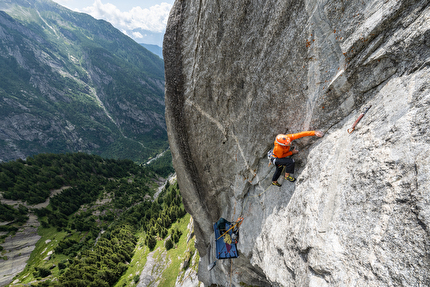
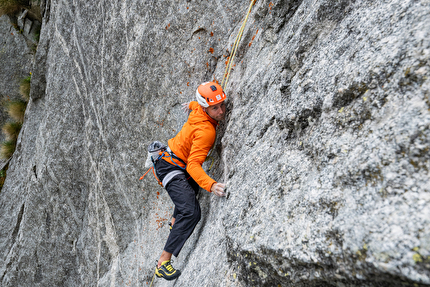
 See all photos
See all photos